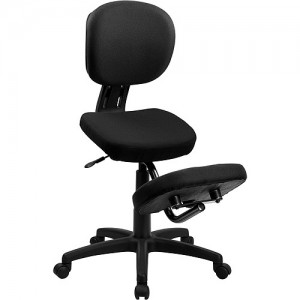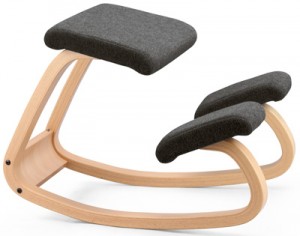Long before the treadmill desk and the ball chair became the hip alternative means to work at your desk, kneeling chairs were all the rage among an alternative piece of the population. A cousin of mine had one in the early eighties and I remember thinking it was silly and none too comfortable.
After writing about standing desks a couple of weeks ago a reader wrote to ask me to write about kneeling chairs and their efficacy. Well, I am happy to take requests so here you go:
Created in 1979 by Peter Opsvik and originally called the Balans chair, kneeling chairs are a radical rethinking about the way we sit.
Our world, for some insane reason, is not designed for good posture and movement patterns. Ergonomics, which should be the raison d’etre of any chair design, don’t seem to enter into the thought processes of the designers.
Having written before about the evils of both desks and car seats I am happy to weigh in on Kneeling chairs. The basic idea of the kneeling chair is to change the alignment of the knees in relation to the hips.
In traditional chairs we essentially create a series of right angles between the upper and lower leg, and the upper leg and the torso. Kneeling chairs open the angles creating more space in the hip creases. The tilted angle of the seat pitches the body slightly forward which requires something for the shins to rest on so that the sitter doesn’t fall out of the seat.
The effect of this position is to create a more optimal alignment of the spine while supported the correct curve of the lower back. So, where our traditional right angle chairs often end up pulling the low back into a c-curve if you don’t remain conscious of your alignment, kneeling chairs pretty much keep your spine in a fairly good position.
The fact that the trunk isn’t leaning on a backrest is also a good thing. One of the problems with traditional chairs is they encourage sloth. You can just kind of mold into them and they will absorb you, holding you up regardless of the quality of your alignment.
While maintaining a properly aligned spine is unquestionably a good thing, other aspects of the chair strike me as odd enough to stay away. I don’t have a great need to rest on my shins and I don’t love the position that foot maintains. Even though the well aligned spine is in a good space, the lower body isn’t particularly free to move. The legs are fairly set into their positions without space to shift. I also like my feet flat on the floor.
Because of the lack of lower body mobility I don’t think I would recommend using kneeling chairs as your exclusive chair but, as with shoes, I am into mixing things up and adding a kneeling chair to an office that is also equipped with a ball chair and a standing desk would be a fine idea indeed. If you can convince a few co-workers to get on the rotating chair bandwagon, you might be onto something.
For what it is worth, I use a Herman Miller Aeron chair that I have had for about fifteen years. While I spend plenty of time in it slouching and spreading my legs and too open hips, I am also able to sit in it correctly maintaining good posture for long periods of time. I am lucky enough to not be sitting at my desk for more than a couple of hours at a time which makes sitting in any kind of chair possible.
***



